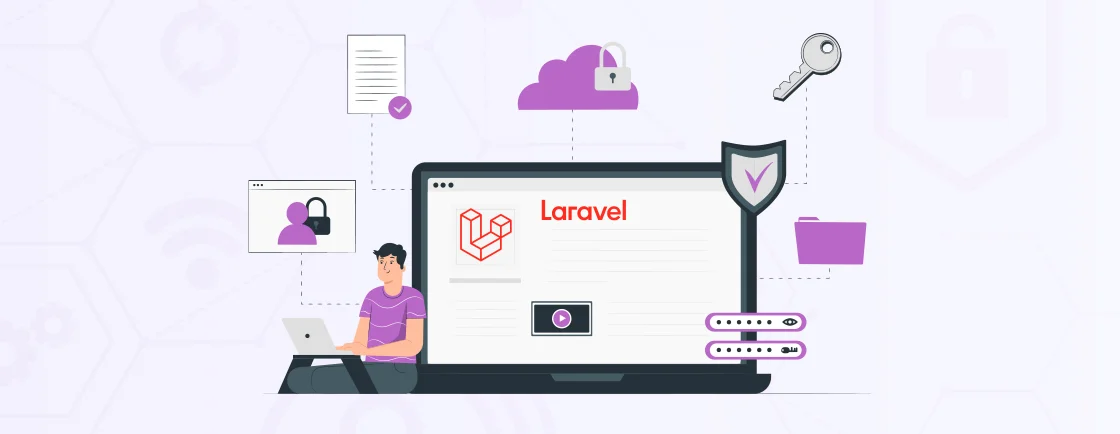Quick Summary
Attempting to decrypt a Laravel-hashed password is both impossible and counter to security fundamentals. Hashing is a one-way process using robust algorithms like bcrypt. This guide clarifies that you cannot reverse a hash but will detail the correct, secure method for password verification using Laravel’s built-in Hash::check() functionality.
Table of Contents
Let’s start with a simple “No”. No, you can’t decrypt a hash password. The hash password is stored in the database as an indecipherable string of characters—that is, a hash.
This fundamental security measure in Laravel is designed to be a one-way process, intentionally preventing passwords from being easily retrieved. Attempting to “decrypt” a hash password in Laravel is a violation of core security principles and is technically infeasible.
But still, this blog showcases what hash passwords are, how they work, and how you can manage them (rather than decrypt them). Let’s get straight into it.
What is Password Hashing?

Password hashing is a fundamental, one-way cryptographic security strategy. It secures the passwords by turning them into fixed-length, unreadable character strings.
Once a password is hashed, even the administrator can’t convert it back to its original form. So even if a database is uncompromised, attackers can’t easily access the original passwords. That renders the stolen data significantly less valuable.
Laravel uses robust algorithms like bcrypt and argon2 by default, which incorporate a random “salt” for each password. The salt produces Laravel unique hashes for identical passwords, ensuring each password remains distinct even if users choose the same credentials. It effectively helps defend against pre-computed rainbow table attacks.
How Does Password Hashing Work in Laravel?
Password hashing passes a user’s plain-text password through a cryptographic algorithm. It generates a unique, fixed-length string of characters called a “hash”. This process is as crucial for application security as implementing proper Laravel rate limit measures to prevent brute-force attacks.
This security approach is deterministic. So the same input will always produce the exact same output. But it’s designed to be irreversible.
Here’s how it works.
Password input → Salt generation → Hashing algorithm → Secure storage
#1 Password Input
It begins when a user creates an account or updates their password. The user submits their plain-text password through a login form.
#2 Salt Generation
The system automatically generates a unique, random string of data known as a “salt.” This salt is different for every single password.
#3 Hashing Algorithm
The system combines the user’s password and the unique salt. Then it feeds this combination into a cryptographic hashing algorithm (like bcrypt, which Laravel uses by default). This algorithm performs complex mathematical operations. The output is a fixed-length, scrambled hash value.
This process is intentionally computationally intensive to slow down brute-force attacks.
#4 Secure Storage
The final hash incorporates the result of the hashed password and salt. It’s stored in your database. The original plain-text password is immediately discarded and never saved.
During future login attempts, the system repeats this process with the user’s input and verifies it against the stored hash.
Is It Possible to Decrypt a Hash Password in Laravel?
No, you cannot decrypt a hash password in Laravel, or in any secure system for that matter. This is not a limitation of the framework but a fundamental feature of robust security design.
The reason behind that is the core difference between hashing and encryption.
- Encryption is a two-way process. Plain text is scrambled into ciphertext using a key, and that same key can decrypt it back to the original text.
- Hashing is a one-way function. It irreversibly transforms input (a password) into a unique fixed-size string. Laravel uses powerful algorithms like bcrypt and argon2 that are mathematically designed to be infeasible to reverse.
So, a hashed password can’t be “decrypted”. The only legitimate method to verify a password is to hash the user’s login attempt and compare the new hash with the stored one. If they match, the password is correct.
Note: Any claim or method offering to “decrypt” a hash is NOT a legitimate solution. It’s promoting a security vulnerability or a brute-force attack.
How to Manage Hashed Passwords in Laravel?
Again, let me make it clear that decrypting hashed passwords in Laravel is not possible. However, Laravel provides functionalities for managing password security. Here are the relevant methods.
Using Hash::make() Method
This method is crucial for securely storing passwords. It takes the plain-text password as input and generates a unique hash using a chosen hashing algorithm (Bcrypt by default). This hash is then stored in the database, not the original password. Here’s an example:
$password = 'mySecretPassword';
$hashedPassword = Hash::make($password);
Using Hash::check() Method
This method is used during login attempts. It takes the entered password and compares it to the stored hash. It utilizes the same hashing algorithm and salt used during password creation to generate a new hash from the provided password. If the newly generated hash matches the stored one, the login is successful.
$enteredPassword = request('password');
if (Hash::check($enteredPassword, $hashedPassword)) {
// Login successful
} else {
// Login failed
}
Using Hash::needsRehash() Method
Hashing algorithms are constantly evolving to improve security. This method checks if the stored hash requires updating with a more secure algorithm due to advancements. If necessary, it automatically re-hashes the password using the latest algorithm, enhancing overall security.
if (Hash::needsRehash($hashedPassword)) {
$hashedPassword = Hash::make($hashedPassword);
// Update the stored hash with the newly generated one
}
Remember, these methods focus on secure password management through hashing and verification. You can’t retrieve the original password in plain text.
So if you want help with decrypting hash passwords on your Laravel website, you can consult with our Laravel development agency.
How to Implement Encryption in Laravel?
Password hashing is for one-way, non-reversible protection. But Laravel provides a separate, robust system for two-way encryption using the OpenSSL library.
Laravel encryption and decryption uses a single key, defined in your application’s .env file as the APP_KEY.
You can encrypt and decrypt data using Laravel’s Crypt facade.
To Encrypt Data
use Illuminate\Support\Facades\Crypt;
$encryptedValue = Crypt::encryptString('Sensitive API Key');
// Store $encryptedValue in your database.
To Decrypt Data
use Illuminate\Support\Facades\Crypt;
$decryptedValue = Crypt::decryptString($encryptedValue);
// $decryptedValue is now 'Sensitive API Key'
Important Distinction: Remember that this two-way encryption is not a substitute for password hashing. Always use Hash::make() for passwords and Crypt::encryptString() for data you intend to retrieve in its original form.
Best Practices for Password Management in Laravel
If you’re not comfortable with decrypting hash passwords in Laravel, there are some alternative approaches. These include resetting the password through secure procedures or utilizing reputable third-party decryption tools. These methods can handle some specific decryption requirements.
Password Reset Mechanism
Instead of attempting to retrieve the original password, Laravel provides a robust password reset mechanism. This allows users to initiate a password reset process by providing their registered email address. Laravel sends a secure token to the user’s email, which they can use to set a new password. This approach ensures that even if an attacker gains access to the hashed passwords, they cannot access accounts without the user’s knowledge.
Secure Password Storage
Laravel utilizes strong hashing algorithms like Bcrypt and Argon2 to store passwords. These algorithms add significant layers of security, making it computationally impractical for attackers to crack the hashes and retrieve the original passwords.
Password Validation
Enforce strong password policies when users register or change their passwords. This includes minimum password length, character requirements (uppercase, lowercase, numbers, special symbols), and avoiding common dictionary words. Stronger passwords translate to more robust hashes, further enhancing security.
Password Re-hashing
Laravel’s Hash::needsRehash() method helps maintain optimal security by checking if the stored hash requires updating with a more secure algorithm as hashing standards evolve. This ensures that even older passwords stored in the database benefit from the latest security advancements.
Regular Security Audits
Conducting regular security audits (as a part of the site maintenance services) is crucial. This helps identify potential vulnerabilities and implement necessary security measures to protect user data.
Remember, the primary goal is to securely manage user credentials, not to retrieve the original passwords.
Common Mistakes to Avoid When Hashing Passwords in Laravel
Proper password hashing is critical for application security. Even within a framework like Laravel that provides robust tools, developers can inadvertently introduce vulnerabilities. Here are the key mistakes to avoid:
Attempting to ‘Decrypt’ Hashes
The most fundamental error is treating the Hash::make() function as reversible. Hashes are designed to be one-way. Any attempt to decrypt them undermines their entire security purpose.
Using Weak Algorithms
Never bypass Laravel’s default hashing driver. It uses bcrypt, which is currently considered secure. Avoid configuring your application to use outdated algorithms like MD5 or SHA1, which are vulnerable to brute-force attacks.
Manually Hashing Without Verification
Simply running a password through Hash::make and saving it is not enough. You must use the Hash::check() method for verification during login. This function correctly handles the internal salt and comparison.
// Correct Verification
if (Hash::check($request->password, $user->password)) {
// Password matches
}
Using Custom, Complex Salting Logic
Laravel’s bcrypt implementation automatically generates and manages a secure, unique salt for each password. Manually creating and concatenating your own salts is unnecessary and can introduce security flaws.
Re-hashing on Every Login
The system should hash the password once upon creation or update. There is no need to re-hash and re-store the password on every successful login, as the hash itself does not change.
Final Summary
Hashing is a one-way security measure designed to safeguard user passwords, not a reversible encryption process.
Attempting to crack the hash is futile. But Laravel provides robust tools for secure password management. That includes verification, password resets, and enforcing strong password requirements.
So, if you want to implement the best security practices on your Laravel site, hire Laravel developers with us today!
FAQs on Decrypting Hash Password in Laravel
Why can’t I decrypt a hashed password?
Hashing algorithms like Bcrypt and Argon2 transform passwords into unique, unreadable strings. This process is irreversible, meaning there’s no mathematical way to retrieve the original password from the generated hash.
What happens if someone gains access to the stored hash values?
Even if an attacker obtains the stored hash values, they cannot decipher them back into the actual passwords. This is a deliberate security measure to safeguard user data even in the event of a security breach.
Are there any alternatives to storing passwords in hashes?
Consider exploring passwordless authentication methods like email magic links or security tokens. These eliminate the need for storing passwords altogether, further enhancing security and user experience.
What should I do if my hashing algorithm becomes outdated?
Laravel is designed to handle this scenario gracefully. You do not need to manually decrypt and re-hash all your user passwords.
When a user successfully logs in with their old password, you can automatically re-hash it using the new, stronger algorithm and update their database record. Laravel’s Hash facade can check against an old hash while allowing you to save a new one.
How do Laravel Passkeys improve authentication security?
Laravel Passkeys offer a passwordless authentication method that enhances security and user experience. Instead of relying on traditional passwords, passkeys leverage public-key cryptography, eliminating the risks associated with password leaks or weak credentials.
Secure Password Handling in Laravel
Can't (and shouldn't) decrypt hashed passwords — ensure safe authentication, proper hashing, and secure reset flows with expert help.





